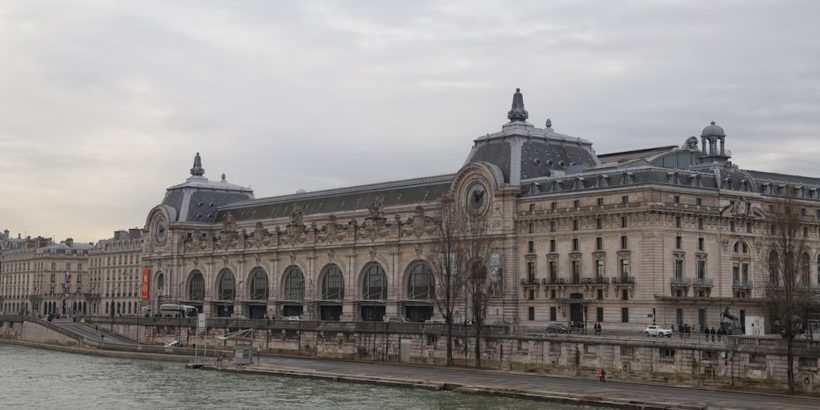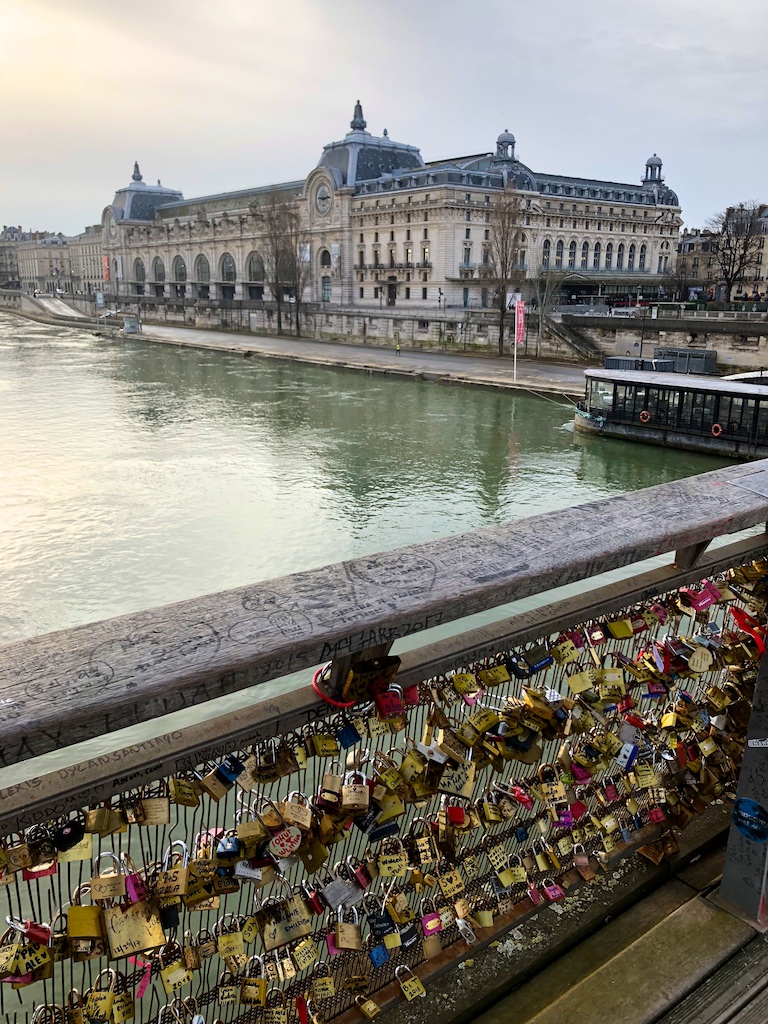Are you planning a visit to the Musee d’Orsay (Orsay Museum) or thinking about visiting?
This article will tell you everything you need to know about the Musee d’Orsay, including how to get tickets, beat the lines, and some interesting facts about its history and the artwork you’ll find within the museum.
If you’re just looking for tickets, then feel free to click here to go straight to tickets.
Table of Contents
Musee d’Orsay History
The Musee d’Orsay’s building was originally a railway station, known as Gare d’Orsay. It was constructed for the Chemin de Fer de Paris à Orléans and finished in time for the 1900 Exposition Universelle.
The Exposition Universelle was the world’s fair created to celebrate society’s achievements and it’s where many pople were introduced to things like the Ferris wheel, Russian nesting dolls, diesel engines, talking films, and escalators.
The Musee d’Orsay was designed by three architects:
- Lucien Magne
- Émile Bénard
- Victor Laloux
The building was the terminus for the railways of southwestern France until 1939. By 1939, the station’s platforms were no longer suitable for the larger trains that were routing through the area.
So the building was used for suburban services and it became a mailing centre during World War II.

Almost destroyed
In 1970, the building was almost destroyed when permission was granted to demolish the station.
However, Jacques Duhamel, Minister for Cultural Affairs, ruled against plans to build a new hotel over the building. The station was then eventually added to a list of Historic Monuments in 1978.
When was the building turned into a museum?
The Directorate of the Museums of France suggested that the station be turned into a museum. They wanted to build a musueum that would act as a bridge between the the Louvre and the National Museum of Modern Art at
The plan was then later accepted by Georges Pompidou and a study was commissioned in 1974.
In 1978, they held a competition for the new museum’s design. ACT Architecture, consisting of a team of three young architects, were awarded the contract which involved the creation of 220,000 square feet of new floorspace across four floors.
In 1981, the Italian architect Gae Aulenti was chosen to design the interior of the building, which included the internal arrangement, decoration, furniture and fittings of the museum.
Then, in July 1986, the museum was ready to receive its exhibits. After about six months of installing around 2,000 paintings and 600 sculptures, the museum officially opened in December 1986.
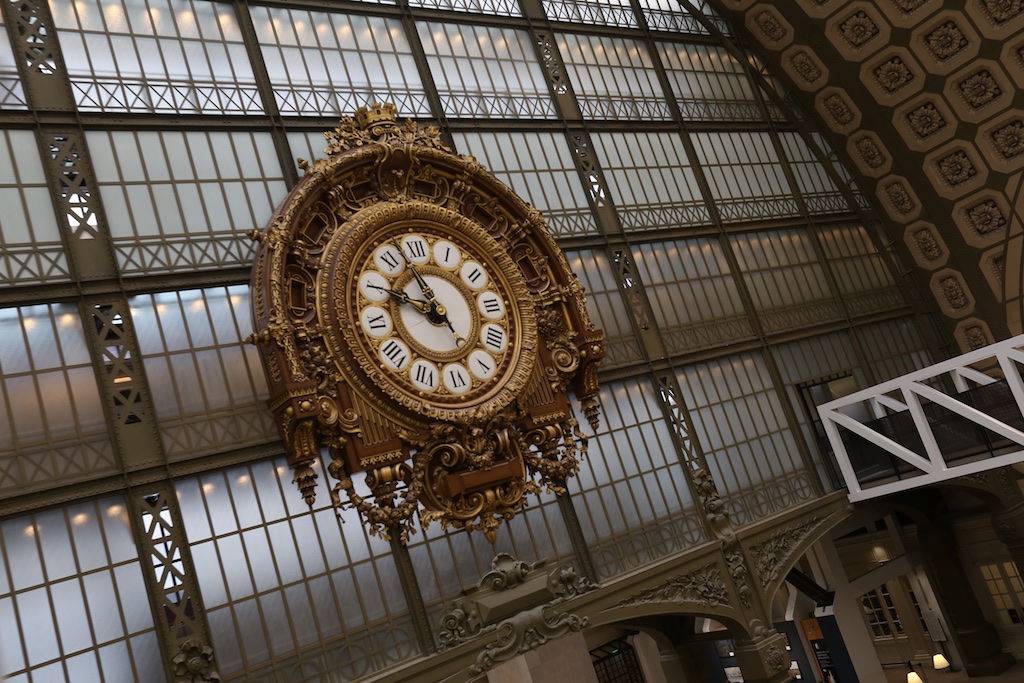
What is the Musee d’Orsay?
It is one of the premier museums in Europe and houses primarily French art dating from 1848 to 1914. You’ll find various works of art including paintings, sculptures, furniture, and photography.
It houses the largest collection of impressionist and post-Impressionist masterpieces in the world, by painters including:
- Monet
- Manet
- Degas
- Renoir
- Cézanne
- Seurat
- Sisley
- Gauguin
- Van Gogh
Where is the Musee d’Orsay?
The Musee d’Orsay is a museum located in Paris, France, right along the Seine River, near the Louvre.
Here is the estimated walking time to nearby attractions:
- Louvre Museum: 15 minutes
- Palais Garnier – Opera National de Paris: 22 minutes
- Cathédrale Notre-Dame: 25 minutes
- Luxembourg Gardens: 25 minutes
- Eiffel Tower: 30 minutes
- Centre Pompidou: 30 minutes
- L’Arc de Triomphe: 40 minutes
Musee d’Orsay Artwork
The artwork arguably begins before you even enter inside the museum.
Statues outside of the Musee d’Orsay
When you first approach the Musee d’Orsay you’ll notice six statues outside the building. These were built for the 1900 Exposition Universelle and symbolize six of the seven continents.
- South America by Aimé Millet
- Asia by Alexandre Falguière
- Oceania by Mathurin Moreau
- Europe by Alexandre Schoenewerk
- North America by Ernest-Eugène Hiolle
- Africa by Eugène Delaplanche
Van Gogh
Starry Night Over the Rhone
Starry Night Over the Rhone was was painted at a spot on the bank of the Rhône that was only a one or two-minute walk from the Yellow House.
Van Gogh was a master of capturing the light of the night’s sky as well as the light reflecting from gas lamps, and this painting is almost a precursor to his more famous work that came a little later, The Starry Night.
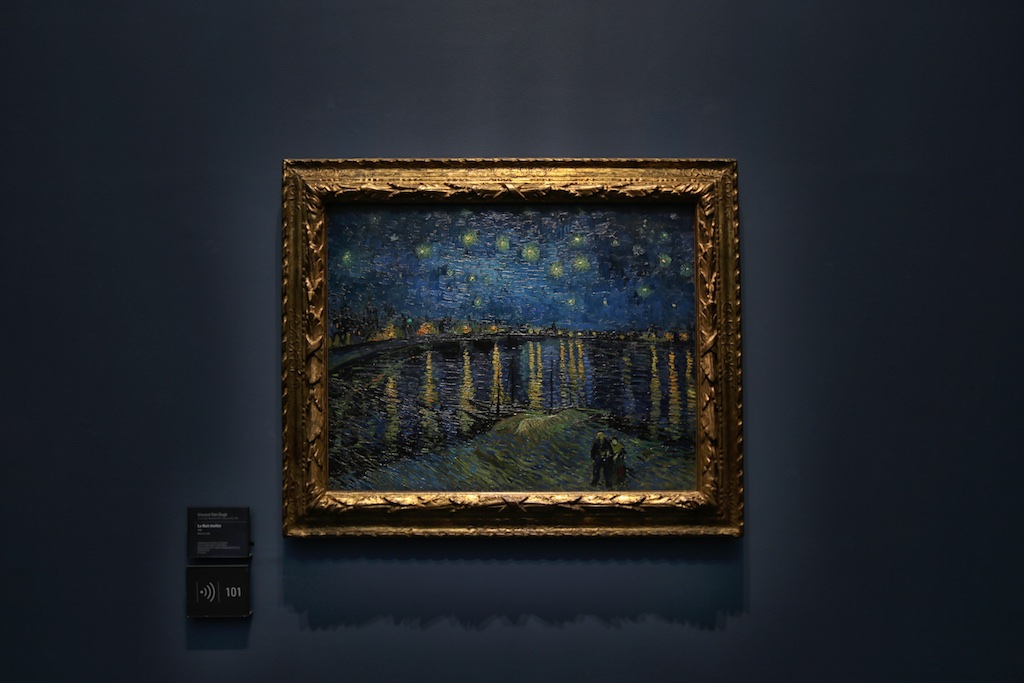
Bedroom in Arles
Van Gogh painted three of his famous bedroom works which depict his famous house in Arles, Bouches-du-Rhône, France, known as the Yellow House. The door to the right opened on to the upper floor and the staircase and the door to the left led to the guest room Van Gogh prepared for Gauguin.
The Bedroom painting at the Musee d’Orsay, painted in September 1889, is the third and final of the bedroom series. The first one painted in October of 1888 can be seen at the Van Gogh Museum in Amsterdam and the second Bedroom painted in September 1889 can be found at the Art Institute of Chicago.

Self-Portrait
Many times, Van Gogh painted self-portraits because he lacked the funding to pay for a model. Van Gogh produced over forty-three self-portraits, paintings or drawings in ten years. The self-portrait at the Musee de’Orsay is special because some art historians think that it might have been the final self-portrait painted by Van Gogh.
It’s easy to forget about the depth that went into painting these self-portraits for artists like Vincent Van Gogh.
He was once wrote to his sister:
“I am looking for a deeper likeness than that obtained by a photographer.”
And later to his brother:
“People say, and I am willing to believe it, that it is hard to know yourself. But it is not easy to paint yourself, either. The portraits painted by Rembrandt are more than a view of nature, they are more like a revelation”.

Claude Monet
Clause Monet was a French painter, and is perhaps best known as the founder of French Impressionist painting and the most prolific practitioner of the movement.
Something interesting about Monet is that he began experiencing cataracts in the 1920s and had surgeries to remove them. But some of his paintings during this time have have a general reddish tone, which is characteristic of the vision of cataract victims.
It’s possible that after his surgery he was able to see some ultraviolet wavelengths of light normally excluded by the lens of the human eye; and this could have had an effect on colors he saw and painted.
After his surgeries, Monet actually repainted some his water lilies to make them bluer than before.
The museum has 86 of his paintings including:
- The Saint-Lazare Station
- The Rue Montorgueil in Paris. Celebration of 30 June 1878
- Wind Effect
- Series of The Poplars
- Rouen Cathedral
- Blue Water Lilies

Gustave Courbet
Jean Désiré Gustave Courbet was a French painter who led the Realism movement in 19th-century French painting. The museum features 48 of his paintings including: The Artist’s Studio, A Burial at Ornans, Young Man Sitting, L’Origine du monde.
Pierre-Auguste Renoir
Pierre-Auguste Renoir, also known as Auguste Renoir, was a French artist who was a leading painter in the development of the Impressionist style, alongside Claude Monet, in the late 1860s.Renoir is known for adding a human element to his work, often working in scenes with families and well-dressed Parisians
The museum has 81 of his paintings including Bal au moulin de la Galette, Montmartre.
Paul Gauguin
Eugène Henri Paul Gauguin was a French post-Impressionist artist who is recognized for his experimental use of color and Synthetist style that were distinctly different from Impressionism. You can find 24 of his paintings including Tahitian Women on the Beach.
Musee d’Orsay Tickets
Standard admission
Tickets currently cost €12 which will get you into the the permanent collections, and for temporary exhibitions, subject to availability.
Skip the line
I recommend getting tickets to skip the line at a dedicated entrance. You can easily order your tickets and save them to your smartphone so that you don’t have to worry about printing anything out if you go with the tickets below:
Audio Guides
You can hire audio guides for €5 per audioguide.
These audio tours are available in French, English and Italian.
Concessions
The museum offers discounted tickets at the rate of €9 for the following:
- For 18-25 year olds who are not citizens or long-term residents of an EU member state
- For everyone from 4.30pm (except Thursdays)
- For everyone on Thursday evenings, from 6pm
Here’s the proof that you’ll need.
Free admission
Also, the following can get free entry:
- Everyone on first Sunday of the month
- Under 18 year olds
- 18-25 year olds who are citizens or long-term residents of an EU member state
- Disabled visitors with one extra person
- Unemployed visitors
- Holders of a Paris Museum pass
- Carte blanche cardholders
- Members of the Louvre Abu Dhabi
- Members of the Société des Amis du Musée d’Orsay or of American Friends of the Musée d’Orsay
Musee d’Orsay Hours
- The museum is open from 9.30am to 6pm daily, except Mondays
- It stays openlate night on Thursdays until 9.45pm
- The last tickets are sold at 5pm (9pm Thursdays)
- The museum is cleared at 5.15pm (9.15pm Thursdays)
- The museum is closed on Mondays, on 1 May and 25 December
Musee d’Orsay Map
There’s a floorplan map that you can pull up online if you want to get an idea of the layout of the museum. It’s not very difficult to get around if you pick up a map when you enter so I don’t think this is a museum like the Louvre where you need to have a game plan as to where you’re going to go.
But the floor plan can still come in handy when you’re trying to find specific pieces of art.
Musee d’Orsay clock
One of the coolest features of the Musee d’Orsay is located on the 5th floor and it’s an area where you can lookout to Paris and the Seine River through the face of a massive clock.
If you visit the museum, you definitely need to check out the clock.

Musee d’Orsay Restaurants
There are a few different places to eat in the Musee d’Orsay and you can read about these places here.
But here’s a quick breakdown:
Café de l’ours
- Tuesday – Sunday, 9.30am to 4.45pm, Thursdays 9.30am to 19.45pm
- Menu here
The Café Campana
- Tuesday – Sunday, 10am to 5pm, Thursdays till 9pm
- Menu here
Restaurant
- Tuesday – Sunday, 9.30am to 5.45pm (groups to arrive at 11.45am), Thursdays till 9.30pm
Tea room 2.45pm to 5.45pm - Menu here
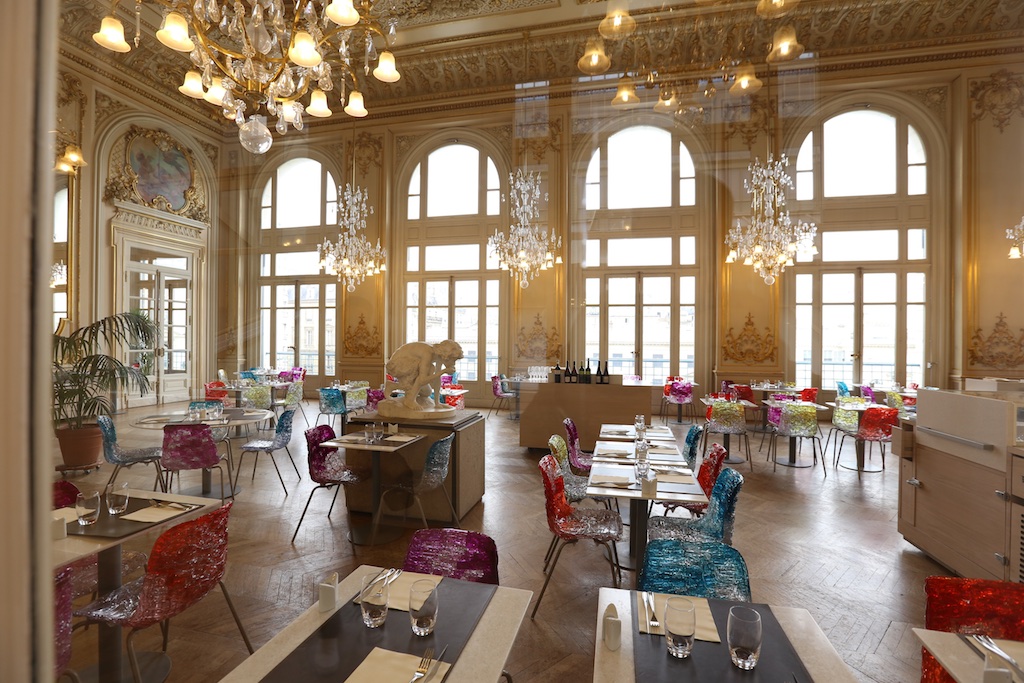
Musée d’Orsay Gift shop
The main gift shop is located at the entrance to the museum and accessible with the museum admission ticket.
The Musée d’Orsay’s bookshop-gift shop is open from Tuesday to Sunday, from 9:30am to 6:30pm, with late night opening on Thursdays until 9:30pm
Hotels near the Musee d’Orsay
During our stay we stayed at the Park Hyatt-Vendome. It’s one of the premier hotels in the area but I wasn’t completely thrilled with the stay, to say the least.
- You can find more hotels in the area here.
Musee d’Orsay FAQ
Here are some commonly asked questions about the Orsay Museum.
How long do I need to visit the Musee d’Orsay?
The answer depends on your museum preferences. We spent about two and a half hours at the museum and that was fine for us. Some people might want to spend much more time in the museum, though.
Is the Musee d’Orsay a must-see?
I personally think that the Musee d’Orsay is a must-see in Paris. I would prioritize visiting the Louvre Museum first because there are more iconic works there and there’s just more to see but I would try to make my way to the Musee d’Orsay.
If you’re visiting the Louvre make sure you read my tips on visiting.
When was the Musee d’Orsay built?
The original railway station was built in built in 1900 but the museum officially opened in December 1986.
How to get to the Musee d’Orsay by Metro?
- Bus: Line 24, 63, 68, 69, 73, 83, 84 or 94
- Metro: Line 1, Concorde or Tuileries; line 12, Assemblée Nationale or Solférino
- RER: Line C to Musée d’Orsay
Are there free days offered?
Free admission to the Museum for all on the first Sunday of the month.
Final word
What I really like about the Musee d’Orsay is that it’s not too huge of a museum like the Louvre. I never felt like we even came close to getting lost which has happened to us in Museums more times than I’d like to admit. There’s also just a high concentration of really cool, iconic artworks. If you’re interested in impressionist and post-Impressionist you’ll absolutely love this museum.
Daniel Gillaspia is the Founder of UponArriving.com and the credit card app, WalletFlo. He is a former attorney turned travel expert covering destinations along with TSA, airline, and hotel policies. Since 2014, his content has been featured in publications such as National Geographic, Smithsonian Magazine, and CNBC. Read my bio.

